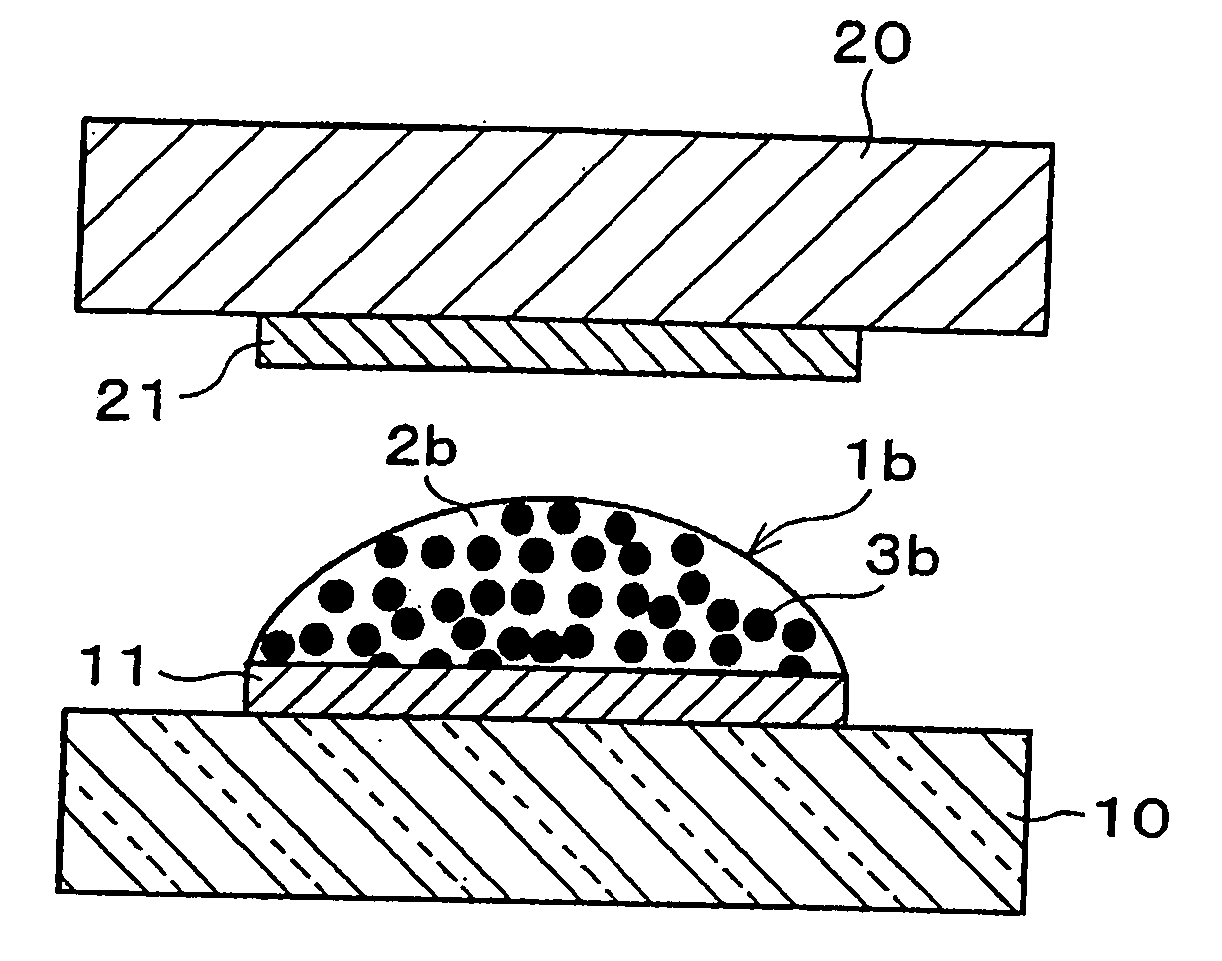Method of interconnecting terminals and method for mounting semiconductor device
a technology of interconnecting terminals and mounting devices, which is applied in the direction of printed circuit assembling, printed circuit manufacturing, printed circuit aspects, etc., can solve the problems of reducing conductivity, affecting and affecting the quality of semiconductor devices, so as to reduce the amount of man-hours, the effect of increasing the yield of semiconductor devices and simplifying the supply of anisotropic electrically conductive resin
- Summary
- Abstract
- Description
- Claims
- Application Information
AI Technical Summary
Benefits of technology
Problems solved by technology
Method used
Image
Examples
example 1
[0101] Copper plates measuring 10 mm×10 mm×1 mm were polished with emery paper and then polished with a buff. Surface treatment was then carried out on a pair of the polished plates by deoxidizing with 6% hydrochloric acid and degreasing by ultrasonic cleaning using acetone. Then, a Sn-48In alloy as electrically conductive particles and Epicron SR-A as a resin were mixed to prepare an electrically conductive adhesive in which the content of the electrically conductive particles was 50% by volume. This electrically conductive adhesive was applied to the surface of one of the copper plates, and spacers made of stainless steel spheres were placed on the surface of this copper plate. Then, the other copper plate was placed atop the electrically conductive adhesive applied to the first copper plate, a weight of 10 g was placed atop the second copper plate, and after sitting for several seconds, the weight was removed and the electrically conductive particles within the electrically condu...
example 2
[0104] A sample after heating was obtained by the same technique as in Example 1 except for using an electrically conductive adhesive obtained by mixing a Sn-48In alloy as electrically conductive particles and Penguin Cement RD-0205 as a resin so that the content of the electrically conductive particles was 30 volume percent.
[0105] The results are shown in FIGS. 10(a) and 10(b). As shown by FIGS. 10(a) and 10(b), it can be seen that an electrically conducting path was formed by a melt of the electrically conductive particles between the pair of copper plates.
example 3
[0106] In order to investigate the surface activating effect of a resin contained in an electrically conductive adhesive, the distance between copper plates was controlled to 300 micrometers, and the molten state of electrically conductive particles was investigated.
[0107] Namely, 10 mm×10 mm×1 mm copper plates were polished by the same technique as in Example 1 and surface treatment was carried out. Then, a Sn-48In alloy (0.8454 g) as electrically conductive particles and Penguin Cement RD-0205 (0.1546 g) as a resin were mixed so that the content of electrically conductive particles was 50 volume percent to prepare an electrically conductive adhesive, and this electrically conductive adhesive was applied to the surface of one of the copper plates. In order to control the distance between the copper plates to 300 micrometers, spacers in the form of stainless steel balls with a diameter of 300 micrometers were placed on the surface of the one copper plate. Then, the other copper pla...
PUM
 Login to View More
Login to View More Abstract
Description
Claims
Application Information
 Login to View More
Login to View More - R&D
- Intellectual Property
- Life Sciences
- Materials
- Tech Scout
- Unparalleled Data Quality
- Higher Quality Content
- 60% Fewer Hallucinations
Browse by: Latest US Patents, China's latest patents, Technical Efficacy Thesaurus, Application Domain, Technology Topic, Popular Technical Reports.
© 2025 PatSnap. All rights reserved.Legal|Privacy policy|Modern Slavery Act Transparency Statement|Sitemap|About US| Contact US: help@patsnap.com



